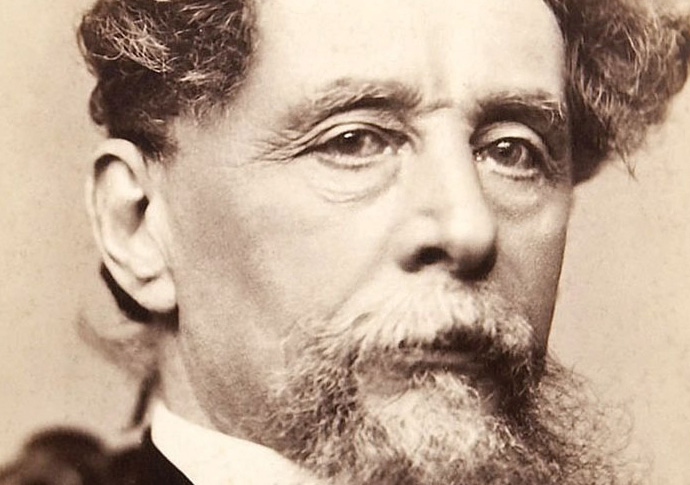Shelf awareness
The story of The David Copperfield Library is unearthed in a new book. Peter Gruner talks to its author
Thursday, 23rd November 2023 — By Peter Gruner

Charles Dickens
LIVING in a small overcrowded terraced house in a poor part of Camden as a boy in the 19th century helped inspire Charles Dickens’s sympathy for society’s underdogs.
A hundred years later, in the 1920s, that house, in former Johnson Street (now Cranleigh Street) Somers Town, faced demolition – until the sudden intervention of a concerned American priest. He argued that the house, which had a plaque to the great author installed by the old London County Council, should be turned into a library for poor children.
And so the story of The David Copperfield Library – something that is virtually forgotten today – is revealed in a chapter of Lee Jackson’s fascinating new book, Dickensland.
Young Charles, aged 12, had moved into the three-storey house opposite a smelly dairy farm in 1824. There were also three sisters, two bothers, dad (John) and mum (Elizabeth). They stayed for five years.
Talking to Review, Jackson, a Victorian historian who lives in Stoke Newington, said: “These were tough times for the family and long before Charles became rich and famous.
“His father John had just been released from Marshalsea debtors’ prison in Southwark and Charles had been forced to work sticking labels on items at a local factory.”
However, life began to improve for his father thanks to an inheritance which meant Charles was able to receive some formal schooling near home at the Wellington House Academy in Hampstead Road between 1824-7.
Moving forward in time to the 1920s, with Dickens long dead, enter New York-born Episcopal priest John Brett Langstaff. He knew about the plan to demolish the old Camden house but believed that Dickens himself would have preferred to see it become a much-needed children’s library for the poor.
Langstaff had served with the British army in the First World War and went on to run the community-based branch of Oxford Magdalen College in Somers Town.
Langstaff was a huge fan of Dickens and convinced that he often used the people of Camden as a basis for many of his popular characters.
The priest’s idea caught on and the old house was donated to Langstaff by local councillor Abraham Davis, who happened to own the freehold to the crumbling terrace. Meanwhile, Langstaff still had to raise a considerable sum to pay for repair and renovation.

Lee Jackson
He took advice from Liberal politician and later newspaper owner Cecil Harmsworth, paid for its restoration and presented it as a museum.
The children’s library appealed to leading figures including HG Wells, Rebecca West, AA Milne and composer Ivor Novello, who offered support.
There were many publicity events like the placing of a wreath on Dickens’s tomb on the anniversary of his death by Harry Adams, aged nine, of Somers Town, who was given much prominence in the press as a “real Tiny Tim”.
The library opened in 1922. Although children couldn’t borrow books to take away, they were encouraged to read as much as they could and a Chief monitored a wigwam on the first floor dedicated to silent reading.
Also there was a Fairy Dungeon in the basement, a toy-strewn crèche where older children could even mind babies.
A Miss De Pollier, who trained at the New York Public Library, provided expertise on book selection and the library also received book donations from publishers and authors and even the French Embassy.
Finally the library was presented as a gift to St Pancras Borough Council with the hope it might build on Langstaff’s work. At the ceremony there were speeches by Queen Alexandra and writer John Galsworthy.
But soon the council became cold about its new responsibilities. The council’s public library committee concluded that this small back street house was “unsuitable for public library purposes” and could not justify the estimated £400 per year cost, which today would be worth more than £20,000.
Meanwhile, Langstaff had returned to the US by 1923 and the library was under the care of an eclectic group of trustees.
However, interest began to wane and the project finally closed in 1931.
Lee writes that there was very little publicity about the closure of the library. This was, at least in part, because another house at 48 Doughty Street, Bloomsbury, was soon to became a Dickens museum.
And, of course, it is still going strong today. Dickens moved to Doughty Street in 1837 when he was becoming a famous young author and wrote Oliver Twist there.
Two years later Charles and his wife Catherine moved to Devonshire Terrace in Marylebone.
Today Doughty Street is a world-famous Dickens museum and Lee’s book is also on sale there. He writes that a lot of Dickensian attractions have disappeared, including The Fleet Prison, depicted in detail in Pickwick Papers, which was closed in 1842 and soon demolished. The unsanitary areas mentioned in Oliver Twist have also fortunately disappeared.
Lee added: “The most remarkable thing about touristic ‘Dickens London’ is its endurance. More than 150 years after the author’s death, one can still purchase guidebooks and take guided tours.”
• Dickensland: The Curious History of Dickens’s London. By Lee Jackson, Yale University Press, £16.99
• The Charles Dickens Museum is at 48 Doughty Street, WC1. Tel: 0207 405 2127